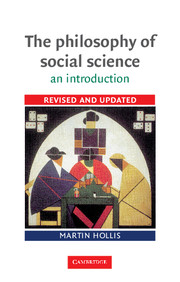Book contents
- Frontmatter
- 1 Introduction: problems of structure and action
- 2 Discovering truth: the rationalist way
- 3 Positive science: the empiricist way
- 4 Ants, spiders and bees: a third way?
- 5 Systems and functions
- 6 Games with rational agents
- 7 Understanding social action
- 8 Self and roles
- 9 Explaining and understanding
- 10 A value-neutral social science?
- 11 Rationality and relativism
- 12 Conclusion: two stories to tell
- Bibliography
- Index
1 - Introduction: problems of structure and action
Published online by Cambridge University Press: 03 July 2012
- Frontmatter
- 1 Introduction: problems of structure and action
- 2 Discovering truth: the rationalist way
- 3 Positive science: the empiricist way
- 4 Ants, spiders and bees: a third way?
- 5 Systems and functions
- 6 Games with rational agents
- 7 Understanding social action
- 8 Self and roles
- 9 Explaining and understanding
- 10 A value-neutral social science?
- 11 Rationality and relativism
- 12 Conclusion: two stories to tell
- Bibliography
- Index
Summary
The 1980s ended with the collapse of communist regimes throughout Eastern Europe. It has become hard to remember how impossible that had seemed. One great certainty of the world since 1945 was that communist and capitalist systems were both here to stay, with the Soviet Union and America as the two poles of a permanently bi-polar international order. Suddenly one pole was disintegrating. I recall switching the television on each morning with gaping disbelief, as governments fell one after another until the Soviet Union stood alone. Then the utterly impossible happened and there was no longer a Union of Soviet Socialist Republics.
Experts were as confounded as amateurs and fought unusually shy of explaining why these events were only to be expected. Brasher pundits who rushed to claim omniscience were received with amusement. The wry mood of Muscovites at the time is nicely caught by a Russian cartoon which I keep on my wall. It shows a tattered Marx, Engels and Lenin seated on a Moscow kerbstone with hats held out for kopecks. Marx is saying to the others, 'But the theory remains true!' At a lofty enough level of abstraction, of course, he could be right. There are ways of reading his work which imply that the Russian revolution in 1917 did not satisfy the conditions for the dictatorship of the proletariat, that the USSR was never socialist and that Soviet hegemony in Eastern Europe after 1945 was a further aberration.
- Type
- Chapter
- Information
- The Philosophy of Social ScienceAn Introduction, pp. 1 - 22Publisher: Cambridge University PressPrint publication year: 1994



